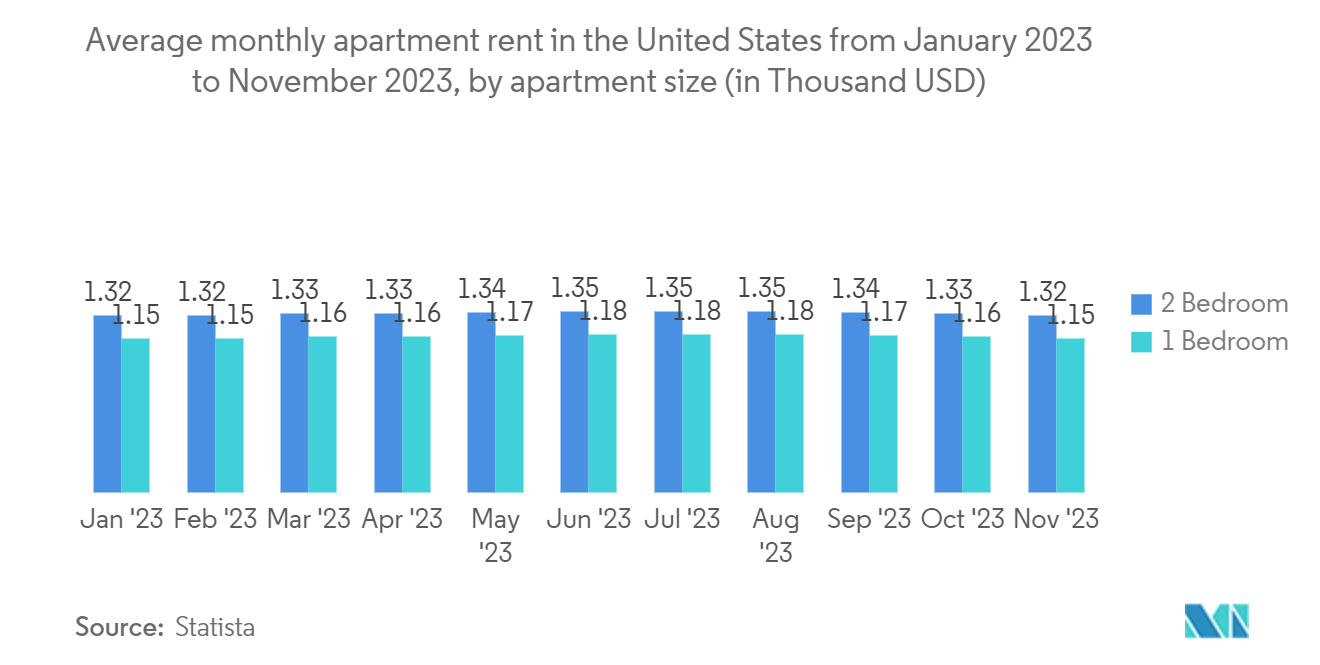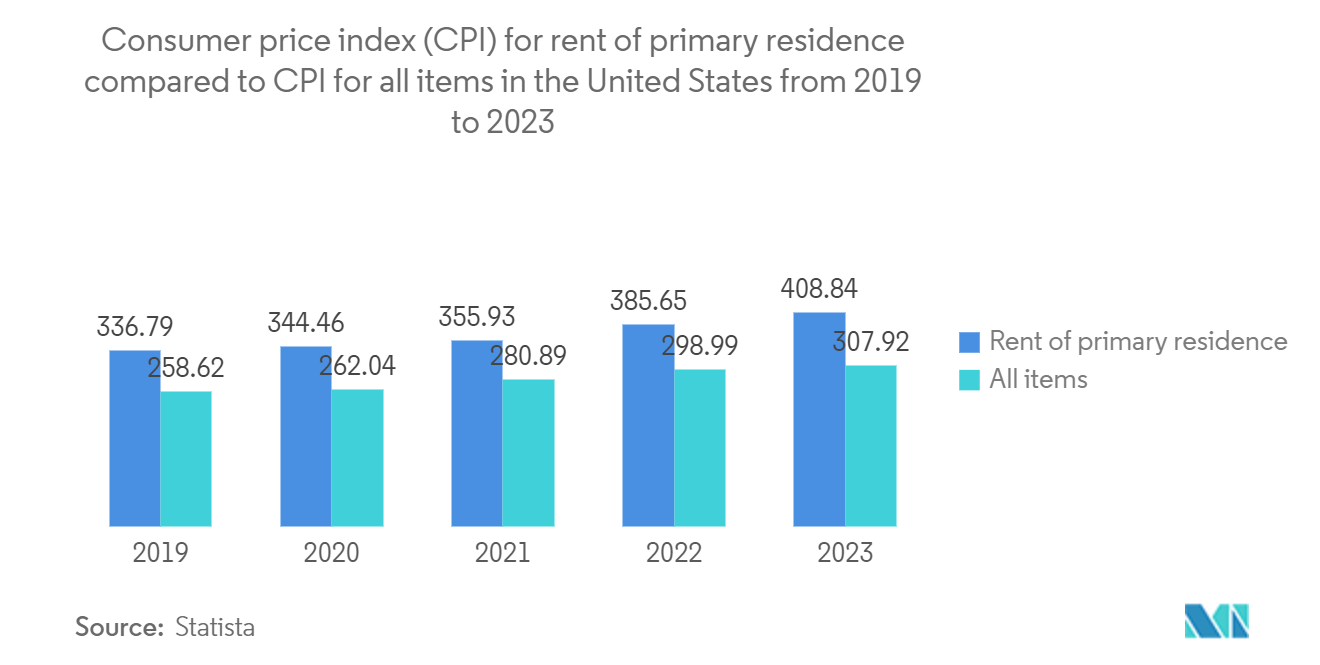United States Rental Rate For Residential Real Estate Price Data

| Historical Prices | From 2020 |
| Forecasted Prices | Next 5 years |
| Frequency | Yearly |
| Products | Apartments and Condominiums, Villas and Landed Houses |
| Regions | United States |
United States Rental Rate For Residential Real Estate Price Trends
Luxury Rentals Surge in Los Angeles Amid High Interest Rates and Mansion Tax
In January 2024, As interest rates soared and Measure ULA (commonly known as the mansion tax) dissuaded potential sellers, 2023 emerged as the year of luxury rentals in Los Angeles. Notable figures, including Rashida Jones, Leeza Gibbons, Maria Bello, Serj Tankian from System of a Down, and podcaster Bill Simmons, have joined the trend, offering their homes for rent. Even Walt Disney's former Tudor mansion is now available for lease. Unsurprisingly, rents, likely boosted by their celebrity associations, have climbed. For instance, NBA star Tyson Chandler listed his Newport Beach mansion for an eye-watering USD 70,000 per month. Data reveals a significant uptick in residential leases: from 291 in 2022 to 490 by November 30, 2023. L.A. saw a rise from 719 leases in 2022 to 884 in 2023, with Douglas Elliman noting a 13% surge in L.A. County. Despite this, real estate brokers are witnessing a growing surplus of luxury rentals, especially those priced at USD 20,000 and above. Many of the most luxurious properties are now vacant, as owners, deterred by the mansion tax, opt to lease rather than sell, possibly due to favourable loan terms.

National Housing Rental Vacancy Rates are rising
In Q1 2024, the national vacancy rate stood at 6.6% for rental housing and 0.8% for homeowner housing. The rental vacancy rate remained steady from Q1 2023 (6.4%) and was on par with Q4 2023 (6.6%). Similarly, the homeowner vacancy rate held at 0.8%, mirroring Q1 2023 (0.8%) and Q4 2023 (0.9%). The homeownership rate, at 65.6%, showed no significant deviation from Q1 2023 (66.0%) or Q4 2023 (65.7%). Regionally, the South led in rental vacancies at 8.4%, trailed by the Midwest (7.0%), the West (5.1%), and the Northeast (4.4%). While the West saw an uptick in rental vacancies from Q1 2023, the Northeast, Midwest, and South remained relatively stable. In terms of homeowner vacancies, the South (1.1%) outpaced the West (0.7%), Midwest (0.6%), and Northeast (0.7%). However, the Northeast, Midwest, and West reported statistically similar homeowner vacancy rates. Across all regions, homeowner vacancy rates mirrored those of Q1 2023. Occupancy rates in the U.S. stood at 89.6% in Q1 2024, with 10.4% of housing units vacant. Owner-occupied units constituted 58.8% of the total, while renter-occupied units made up 30.8%. Increasing vacancy rates often lead landlords to adjust rent prices downwards in a bid to entice tenants. Elevated vacancies signal an imbalance where rental supply outstrips demand, compelling property owners to slash rents to occupy vacant units.

United States Rental Rate For Residential Real Estate Market Price Segmentation
United States Rental Rate For Residential Real Estate Market Price Data by City and Type
The Yearly United States Rental Rate For Residential Real Estate Market Update provides historical and forecasted yearly pricing data in USD/Unit on the Yearly United States Rental Rate For Residential Real Estate Market. The data analysis is available for key markets such as < New York City, Los Angeles, San Francisco, Chicago, Dallas, Las Vegas, Miami, Seattle, San Diego, Houston, Washington, San Antonio>. Types covered include Apartments & Condominiums, Villas, & Landed Houses>. The report also covers the major factors impacting prices of Residential Rental, trade analysis, and demand-supply dynamics.
United States Rental Rate For Residential Real Estate Market Price Data Customization Options
The subscription to this report can be customized on the basis of:
• Forecast period: Subscribe only to the base report or ask us to customize the number of months you need the price forecasts for
• Regions: Subscribe only to specific cities/ New York City, Los Angeles, San Francisco, Chicago, Dallas, Las Vegas, Miami, Seattle, San Diego, Houston, Washington, and San Antonio. data, or ask us to add data for other regions
• Products: Subscribe only to specific products/grades data, or ask us to add data for other products/grades
• Delivery format: Subscribe only to quantitative data in Excel or get the full analysis in a combination of PDF report and Excel data.
United States Rental Rate For Residential Real Estate Market Report - Table of Contents
-
1. INTRODUCTION
-
1.1 Scope of the Report
-
1.2 Market Definition and Study Assumptions
-
-
2. EXECUTIVE SUMMARY
-
3. RESEARCH METHODOLOGY
-
4. HISTORICAL AND FORECASTED PRICE TRENDS 2020 ONWARDS
-
4.1 By Type
-
4.1.1 Apartments and Condominiums (USD per Thousand Unit)
-
4.1.2 Villas and Landed Houses (USD per Thousand Unit)
-
-
4.2 By City
-
4.2.1 New York City
-
4.2.2 Los Angeles
-
4.2.3 San Francisco
-
4.2.4 Chicago
-
4.2.5 Dallas
-
4.2.6 Las Vegas
-
4.2.7 Miami
-
4.2.8 Seattle
-
4.2.9 San Diego
-
4.2.10 Houston
-
4.2.11 Washigton
-
4.2.12 San Antonia
-
-
-
5. HISTORICAL AND FUTURE FACTORS IMPACTING THE PRICE TRENDS
-
5.1 Macro Factors
-
5.1.1 Macro Factors in Residential Rental Market
-
5.1.2 Macro Factors in Regional Markets
-
-
-
6. MARKET SEGMENTATION
-
6.1 Apartments and Condominiums
-
6.1.1 Fundamental Factors
-
6.1.1.1 Supply and Demand Scenario
-
-
6.1.2 Villas and Landed Houses
-
6.1.2.1 Fundamental Factors
-
6.1.2.2 Supply and Demand Scenario
-
-
-
-
7. ANALYST VIEW ON MARKET OPPORTUNITIES AND OUTLOOK
United States Rental Rate For Residential Real Estate Industry Report
Database for the United States Rental Rate For Residential Real Estate prices, historical and forecasted growth and price influencing factors, created by Mordor Intelligence™ Industry Reports. United States Rental Rate For Residential Real Estate price analysis includes a market forecast outlook to next 5 years. Get a sample of this price database as a free report excel download.

